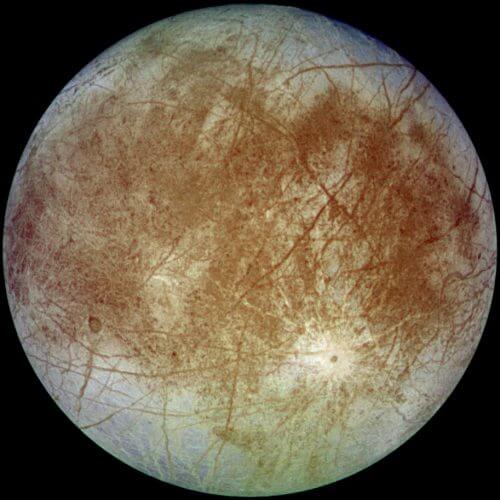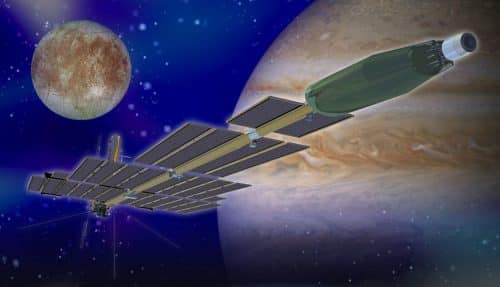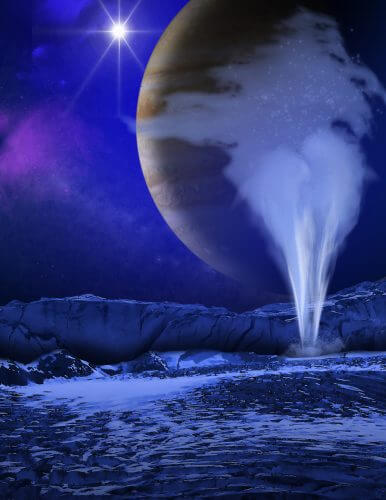For about 40 years, astronomers have estimated that under the ice sheet of Europe there is a huge ocean of salty water. According to estimates, the thickness of the ice layer is 10-100 km and the amount of liquid water is greater than that of all the oceans on Earth

Omri Vandel
After finding evidence for the existence of liquid water on Mars (and see: Omri Vandel - "Water on Mars", "Galileo" 209, February 2016) another frozen world in the solar system is back in the news, which astronomers are quite sure contains large amounts of liquid water - aka Europa, its moon of Tzedek (and see "The Mission: Europe" Oded Avraham, Galileo 193, 2014). For about 40 years, astronomers have estimated that under the ice sheet of Europe there is a huge ocean of salty water. According to estimates, the thickness of the ice layer is 10-100 km and the amount of liquid water is greater than that of all the oceans on earth. These estimates are based on a combination of observations and measurements by the research spacecraft Pioneer 10 and Voyager 1-2 that reached Jupiter in the 70s and "Galileo" that explored the Jupiter system in 1995-2003). Despite several proposals and plans, no dedicated mission has yet been sent to land on this moon - one of the mysteries of the solar system due to the possibility that life may have developed in this ocean, similar to the life found in the depths of the Earth's oceans, or completely different. New observations and studies hypothesize the possibility of life in Europa's ocean and support the launch of future research missions.

After NASA's ambitious Jupiter Icy Moons Orbiter (JIMO) program to explore Jupiter's moons and Europa in particular was canceled in 2005, the European Space Agency (in 2012) approved a more modest program, Jupiter Icy Moon Explorer (JUICE), planned for the twenties. Following the renewed interest, the American space agency announced in 2015 that it intends to send a spacecraft to Europa's moon in the next decade, and the target date for the launch is set for 2022. Recently, the plans have even been upgraded from transits and observations near the moon to landing on its surface, which may delay the launch date [1]. In a May 2016 announcement on the NASA website, it is stated that in the next decade, NASA will launch a research spacecraft with advanced capabilities and radiation shielding into an elliptical orbit around Jupiter, which will include close passes to Europe. During these passes, the spacecraft will take high-resolution images, determine the composition of the ice surfaces and Europa's tenuous atmosphere, and explore in depth the ice sheet, the ocean and its bottom.

Although the surface temperature of Europa is much lower than the freezing point of water, its core is heated by tidal forces arising from the gravitational interaction with Jupiter. This heat allows, according to the astronomers, the existence of liquid water, under the layer of ice that covers its surface. As mentioned, it is even possible that life developed in the ocean below the surface of Europa. This possibility was further strengthened in a recent report [2] from May 2016, that Europa's ocean may be hospitable to the development of life (see for more). The researchers from JPL led by Steve Vance (Steve Vance) reported in an article in the journal Geophysical Research Letters about calculations they made to determine the chemical composition of the ocean, and concluded that it may be more similar to that of the oceans on Earth than previously thought, due to the complexity of the interaction with the bottom, Even without volcanic activity.
"We use methods developed to study the movement of nutrients and energy in the Earth's oceans," said Vance, "the movement of hydrogen and oxygen in Europa's oceans is a major factor in determining the chemical processes and development of life, just like on Earth"
.
The researchers tested the dissolution of hydrogen and oxygen in Europa Ocean water due to the reaction of the salty water with the rock in a process called serpentinization, the entry of water molecules in spaces between mineral grains while releasing hydrogen. Such processes may occur in the cracks that open in the ocean floor due to the cooling of the core of the moon Europa. It is estimated that at the bottom of the Earth's oceans, such cracks reach a depth of about 6 km, while in Europe they may reach a depth of up to 25 km.
The other element necessary for life - oxygen and other compounds - may reach the ocean by reacting with oxidants created in the ice above it by Jupiter's ionizing radiation (see below).
Similar to Io, the innermost moon of Jupiter, which is the most volcanically active body in the solar system, Europa's core is probably also heated by tidal forces resulting from "kneading" by Jupiter's heavy gravity. Therefore, there may be volcanic phenomena on the ocean floor of Europe such as hydrothermal vents that emit hot water rich in minerals, like those found on the ocean floor on Earth.
In the past, researchers believed that volcanic activity was necessary for the development of life in Europa's ocean, to balance the flow of oxygen from the ice sheet. The recent research shows that the cold rock at the bottom of the ocean is more prone to cracking and therefore allows the creation of large amounts of hydrogen, which balances the flow of oxidants.
Another mystery, visible in every detailed photograph of this frozen moon: brown lines crossing the surface of the ice that covers it. In 2013, NASA scientists reported the presence of clay-like minerals (phyllosilicates) on the surface of Europa. It looks like a brown material that fills the many fissures and cracks scattered on its surface [3]. According to a new study, this material may simply be table salt exposed to electron radiation from the radiation belts Possessions of justice [4].
This information may supplement previous findings, such as the 2013 report from the "Hubble" space telescope on the discovery of a "geyser" of water vapor in Europe [5], similar to the water vapor jets on Enceladus, a moon of Saturn.
The article also appears in Galileo, June 2016.
For more information:
[1] About NASA's current space program for Europa's moon
[2] An article on the NASA website about the composition of Europa's ocean
[3] The scientific article on the chemical composition of Europa's ocean
[4] An article in Scientific American about the discovery of the "brown dirt"
. See also "European brown salt", The Science, April 2016.
[5] Discovery of a "geyser" in Europe
